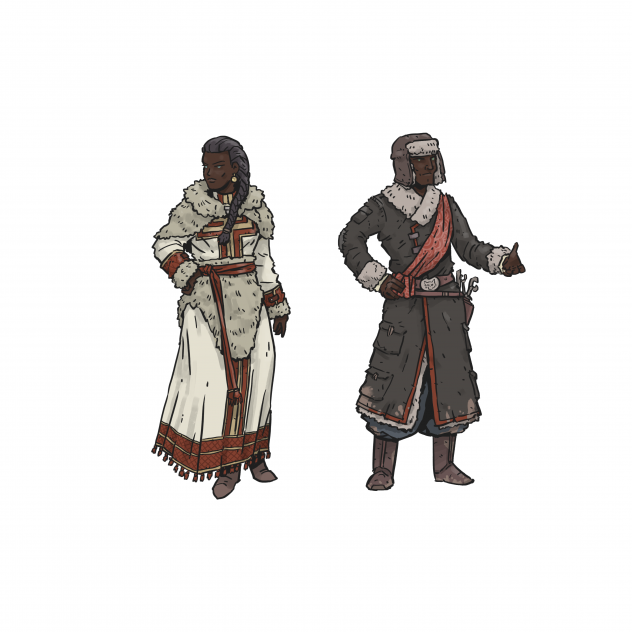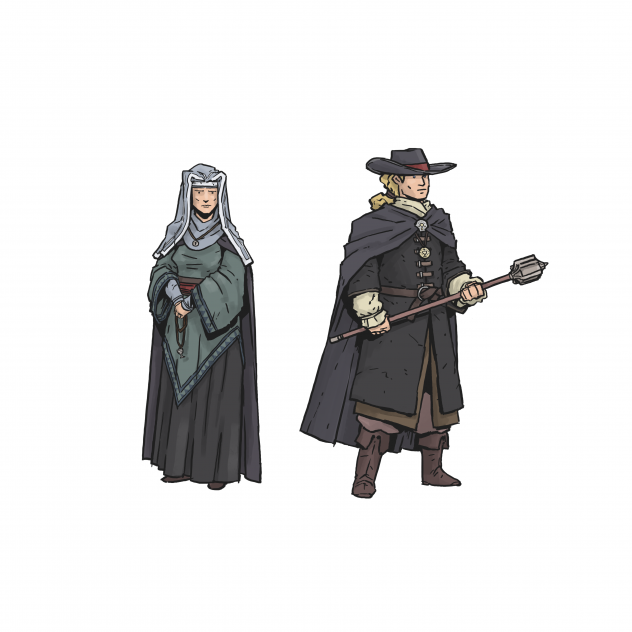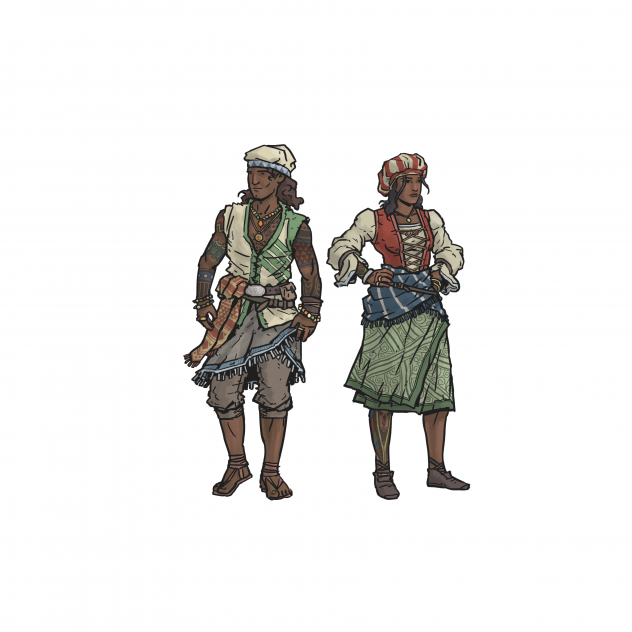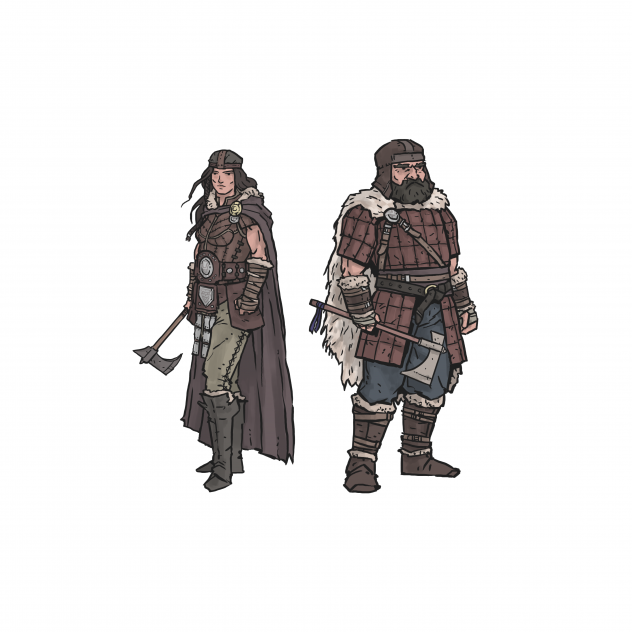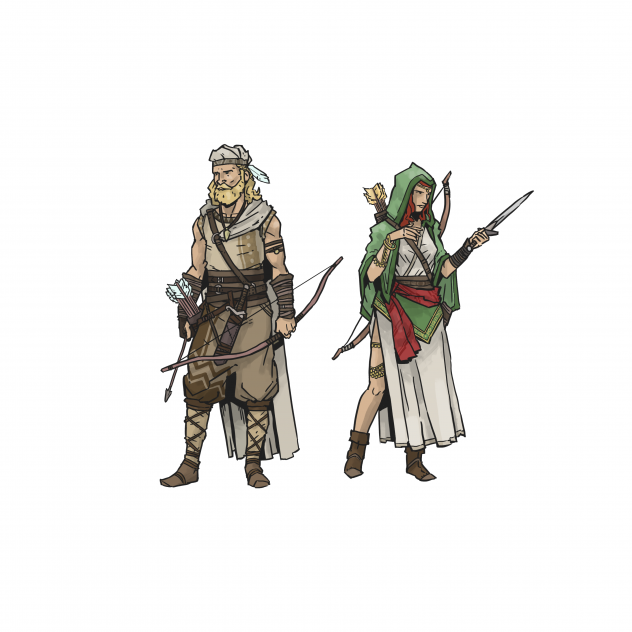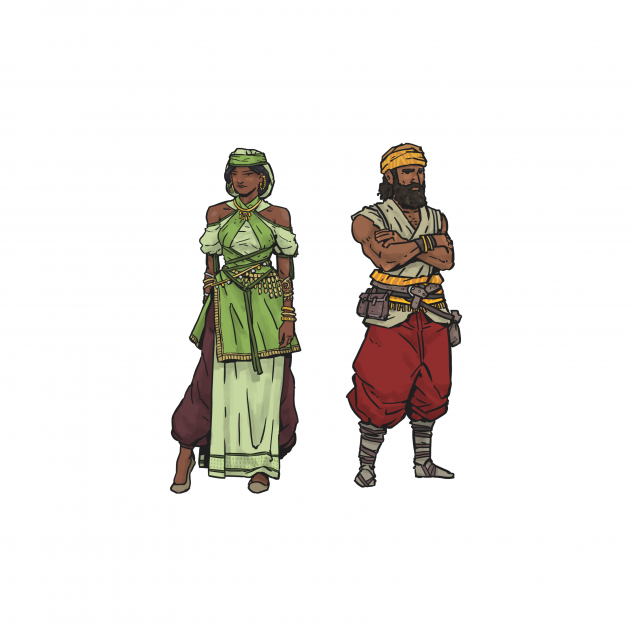Vavardi
FEATURES
Relatively new as a culture, the Vavardi established themselves from Lithmorran stock during the same period as the Consolidation, as a rebellion against new Lithmorran expectations. As such, the Vavardi people are physically very similar to the people of Lithmore, while culturally they take pride in their differences. They are known for trade, craftsmen, artists and a decadent lifestyle. Image is very important in the Vavardi culture, and they work hard to present themselves as urbane and sophisticated.
As a people, the Vavardi tend to be close in appearance to Lithmorrans with dark blonde to brunette hair and light eyes in shades of blue or green to brown. Lighter hues tend to be slightly more common in the skin and hair due to the proximity to the Charali plains, and the Vavardi ideal form is taller and fuller figured, owing to their rich diet.
Average Statsistics
Female: Height 1.68m (5’6″ ft) , Weight 58 kg (130 lbs)
Male: Height 1.73m (5’8″ ft), Weight 64 kg (145 lbs)
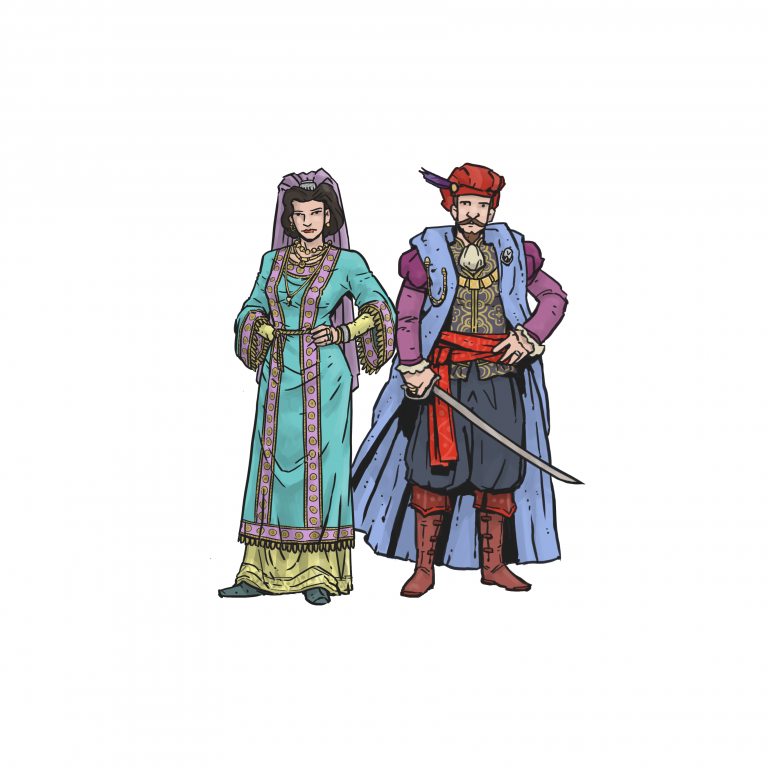
FAITH
The church features heavily as an important part of Vavardi social life. During services, priests generally offer lengthy, elaborate sermons, more as a ritualistic congregation of faith than for the purpose of delivering an especially explicit message. Pomp and circumstance play a heavy role in Vavardi masses with ritual emphasized over personal involvement. A great deal of social expectation and status are also attached to the collection, leading to minor competitions in one’s displays of charity. Representatives of merchant houses will even sometimes send servants in their stead, donating heavily to the church even when they do not attend. Due to the expected contributions to the church, Vavard’s cathedrals tend to hold their own in a duchy of ornate monuments.
The church is considered a relatively prestigious vocation, and many Vavardi priests hail from the gentry class. Promotion through the ranks of the Vavardi clergy is unofficially based on one’s ability to manage funds, and it’s not uncommon for their priests to achieve higher ranks at a much younger age than those in other duchies. The Vavardi also tend to favor sunny yellows in the vestments of their clergy and encourage positive messages that focus more heavily in good works than sins.
FASHION
Fashion is extremely important in Vavard’s appearance-focused culture with much attention paid to clothing and its constantly changing styles. There is a strong societal pressure to keep up with trends and appear fashionable, donning often elaborate and expensive clothing. Compared with other cultures, the Vavardi have much less in the way of typical garments, preferring instead variety and novelty. Nevertheless, some constants do show their way through, in general ideals if not specifics.
The Vavardi ideal prefers a generous figure and soft, curved lines. Garments are designed to accentuate this, built out through layers of cloth rather than rigid structural pieces. Layers are also used heavily as stylistic accents, made visible through differing lengths or splits in the cloth. Various robes are popular with both genders, often as an outer layer, as are sashes, scarves and decorative accents. Full skirts are expected in women’s garments, while hose alone are not considered sufficient leg covering for a man. Decorative patterns are realized through extensive embroidery, brocades and painting done directly on silk. Vavard is also especially well-known for its fine, lightweight silks, and these are used as a preferred material wherever possible. Though jewelry is popular, it is expected to accentuate garments, rather than overshadow them, and, as such, pieces tend to be more delicate and detail-oriented than elsewhere.
Fashion changes with the seasons, dictated more by style than the weather, given the mild climate of Vavard, and these stylistic trends present themselves in multitude different ways. Sleeves vary widely in length and shape, as do necklines and waistlines. Varied design motifs and color palettes cycle through popularity. The use of ribbons, feathers, bows, lace and other embellishments are mixed and matched. Outside of the loose, expected guidelines, fashion is considered open for experimentation.
Vavardi fashion is also not constrained by Lithmorran propriety. Though Lithmorran wisdom accuses that the Vavardi take delight in being lewd in their design choices, it would be more accurate to say that exposed arms or deep necklines are simply not considered indecent and are used where the designer feels appropriate. Though hats are sometimes used, it is not
considered important to cover the hair, especially with the popularity of extravagant hairstyles and dangling curls. Vavardi house silks are any sort of lightweight silken garment designed for wear in the privacy of the home and geared for comfort. Though they can be revealing and have a reputation for such in Lithmore, the intimacy of such garments is considered to be in their simplicity, designed for the wearer alone rather than appearances presented to the outside world.
As is typical in the Vavardi culture, Vavardi fashion is defined by the wealthy, and the lower classes are left to try and keep up. Among those with some money, trade in second-hand clothing is common, selling the previous season’s garments in order to purchase the newest styles. The less money one has, the further behind the popular trends they tend to fall. Many among the lower class also use versatile garments. Women wear multiple skirts of different colors, often all of them that they own, varying in which is worn on top, and then draw the edges of differing layers up under their belt, exposing underlayers or creating a larger poof at the hips. Scarves and sashes which can be worn in many different ways are considered indispensable. Men often have a single fine vest that they can layer over simpler garments like a loose pants and shirt. Cloaks are often designed to be reversible, offering more variety with a single garment.
TRADE
Trade isn’t just an aspect of the Vavardi economy; it is a way of life. Though the duchy supports itself with farming to some extent, it could hardly be called a breadbasket. Instead, Vavard has truly established herself through foreign trade. Originally settled by merchants, the design of the duchy and its way of life was built around the goals of trade and making money. With the Vavardi taste for luxury and novelty, all manner of goods are brought from far and wide through Vavard. Though many of these items are purchased and consumed in the duchy, there are no shortage of traders to carry them on to the other duchies as well. Vavard has especially made a name in the creation and trade of finished goods over raw materials; silks, dry wines, capuan brandies, fine glass and porcelain are all closely associated with Vavard. Goods from Vavard have a reputation for being beautiful, high quality and very expensive. However, this in no way limits the opportunities. There is an axiom that does not hit far from the truth: “If you cannot buy it from Vavard, you cannot buy it anywhere.” The main exception would be that the Vavardi are unlikely to trade in anything that people will not buy for long; most Vavardi are shrewd business people, constantly trying to find a new good or market to outsell their rivals, but they are also quick to drop those they don’t find successful.
In Vavard’s luxury heavy market, another type of good has also distinguished itself: fine arts. Arts of all types are well patronized in the duchy, allowing a class of talented artists to thrive, even exporting their goods on to the wealthy in other regions. Fashion fills a similar niche, viewed as an artform while also creating a constant demand for new clothing.
FOOD
Food is an obsession in the Vavardi culture, and meals are expected to be a delight to all the senses. A traditional Vavardi meal is served one course at a time in an order curated by the host. The number of courses grows with the wealth of the host, but even poor households would try to serve at least two distinct courses on their own and be embarrassed to serve less than three to a guest. On the other hand, it is expected that a guest will try at least a small amount of all courses for which he is present, and the Vavardi palate is usually both adventurous and quick to form an opinion.
A wide variety of ingredients are used in Vavardi dishes. Fresh fish and other seafoods are especially popular, but other meats are also used, both cured and fresh, as are other proteins like cheeses, nuts and eggs, often in combinations of several different proteins. Rices and pastas are more popular starches than potatoes, which are eschewed as bland, and hot, fresh breads are included in most meals. Fruits and vegetables are used heavily, but they are incorporated into the dish itself. Side dishes have no place in Vavardi cuisine, and foods that are unaltered, like straight vegetables, are considered crude. Any single course is expected to stand on its own, presenting a cohesive interplay of flavors and textures, whether it be a few marinated olives or an extravagant meat dish..
Seasoning and sauces are considered highly important. According to the Vavardi mind, the flavors should be subtle and sophisticated, not overpowering the flavors of individual elements. Wealthy households make use of a wide array of expensive, imported spices, while even poor households make a point to keep a small herb garden with as much variety as can be managed. Blandness is practically unforgivable in Vavardi cuisine.
The Vavardi have several other thoughts around food and meals that are sometimes considered odd in other parts of the kingdom. Fancy pastries are well-loved and considered an artform, but it is generally believed that they should be purchased from professional patisseries instead of made in the home. Subtleties are considered the height of style foods made to resemble other objects. Wine is more popular than beer or ale for table drinking, but harder alcohols, such as the famous Capuan brandy, should be served as their own course. Dairy products are more likely to come from goats rather than their bovine counterparts, although milk is not considered a beverage but is instead consumed in cheeses and yogurts.
Most foreigners knowledge of Vavardi food is highly focused around the extravagance of upper class cuisine, perhaps because even lower class Vavardi attempt to emulate that decadence in their own food. Servants eat the leftovers from their masters table as an expected perk of the job; the expected portions ensure there is always plenty for them as well. Other lower class Vavardi are expected to push their finances to make good food, as it is considered a priority, and they make dishes similar to the upper classes that omit expensive imported ingredients, and make use of greater ratios of rice or pasta to meat.
CUSTOMS
Contributions: As a society focused on both wealth and appearances, public contributions have become a popular way to show one’s importance. The more visible and glamorous the cause, the more favor it finds with the Vavardi elite. Thus the arts, public monuments and the church see much more in the way of contribution than do simpler causes like the poor, who try to hide their needs. A person wishing to gain recognition will often go to elaborate lengths to make their giving large and noticeable, and anonymous contributions are viewed as foolish and suspect, rather than noble. This custom has built up Vavard as a center of culture and refinement with names and histories attached to nearly everything.
Patronage: With a good deal of prestige associated with having talented people in ones employ, it has become very common for wealthy Vavardi to offer patronage to all manner of craftsmen, artists and performers. Often starting as soon as a student shows promise early in their schooling, the relationship is more complicated than simply being hired to do a job, including additional perks and expectations of loyalty. Though it is understood that many will seek better offers, leaving a patron before a couple of years of service have passed, or directly after some special favor has been offered, is viewed with contempt.
The Arts: The arts enjoy an elevated position in Vavard not often seen in the other duchies. Nearly all members of the gentry or nobility learn some musical instrument or creative art to a passable level during their school years, and bards enjoy a warm welcome in any circle. Due to an abundance of artists and performers, the bar for fame is held high, and the favorite darlings of society change with the fashions. This leads to intense competition in the artistic community and a strong pressure to maintain ones novelty. Though performances are common throughout the year, Vavards high theater season starts with the New Year celebrations and provides the elite with several celebrated shows every week until Spring to get them through the drab Winter months. These shows begin just after dusk, while cheaper shows are offered just once a week in the afternoons, when the added expenses of lighting arent necessary, providing an opportunity for those who cant secure more expensive and prestigious tickets.
Public Recreation: Leisure and recreation are viewed in Vavard as justly deserved by those who are successful, celebrated rather than derided as lazy or a waste of time. While not fashionable amongst Vavardi women, gymnasiums and varied sports enjoy much favor among their male counterparts. On the other hand, both genders enjoy games of dice and cards, horseback riding, time in the park, or any number of other activities.
Bathhouses: Most Vavardi make heavy use of public baths as a social gathering place to soak, talk, read and relax. Vavardi bathhouses are mixed gender, not at all shy about the mixing of nude men and women. Patrons travel between three different sections of the bathhouse: warm, hot and cold water baths. However, the bathhouses are about more than just bathing, favored for the social experience and as a hotbed of local gossip.
Betrothals: Matrimony is viewed as a business transaction or political alliance, complete with contracts. Once the details are agreed upon by both parties, it is customary for the signing of the contracts to take place at a ceremony in the presence of friends and family. A formal exchange between the couple is part of the tradition; the man will offer a cloak to his future bride, and she will then in turn pour and offer him a glass of wine. This symbolic exchange indicates a willingness of each party to provide not only for the necessities of life, but the pleasures as well.
Wedding Gifts: The Vavardi do not generally exchange nor wear wedding bands, supposedly as a reaction against the Lithmorran fondness for the tradition. However, it is customary for each party to grant the other a significant gift on the day of the wedding. This gift is not a part of the contracts signed, but it is also not considered a romantic gesture; instead, it is an additional display of wealth and a popular topic for gossip.
Feasts: Elaborate dinners are held as a part of any big celebration. The meal is served starting late in the evening, after the main entertainments and dancing, with the expectation that further delights are either culinary or firmly relegated to the background. Courses are served one at a time in an order carefully curated by the host. The grandest affairs include more than a dozen courses of only a few bites each, and it has become a sort of informal contest between hosts to see who can draw out the party the longest. This rivalry has led to a general acceptance that is not impolite to leave any party once the sun has begun to rise, and some hosts have even taken to preparing small, packaged breakfasts for their departing guests to take with them.
EDUCATION
Education is valued in Vavard for its own sake, rather than only for its practical considerations, and a well-balanced curriculum is considered highly important. Music and the arts especially are included much more prominently than they are in other duchies, but more traditional topics are also included.
The nobility and most affluent gentry hire personal tutors for their children. Good tutors are highly sought after and well-paid, offering instruction in politics, laws, economics, religious texts, history, fine arts, music, court dances, etiquette and multiple languages. Further lessons are geared more to the role the child will be expected to fill, including potentially business or household management, statecraft, architecture, warfare, dueling, fashion, embroidery, poetry, singing and playing musical instruments. This tutelage may last until the child is nearly sixteen, when he or she is expected to begin shadowing the appropriate parent and gradually start taking over small duties.
Those whose families cannot afford private tutors begin their education in primary schools. Open to children between the ages of five and ten, lessons are offered without a tuition charge due in large part to the donations of generous benefactors. Though enrollment in these schools is not compulsory, most parents try not to let their offspring miss out on the opportunity, given the strong civic pressure for all citizens to be educated. Classes include reading, writing, counting, art and music, and the young pupils enjoy diverse reading materials, from the Erra Pater to classic plays written by famous bards, from a collection of nursery rhymes to royal speeches. By the end of this education, children are expected to possess the basic knowledge in many fields: economics, arts, laws, music and Lithmorran. Given the heavy funding from donations, school functions are also a frequent occurrence, focused on appeasing the egos of the school’s benefactors through the display of star pupils and artistic presentations of gratitude.
After the age of ten, schools become much more specialized. Donations change greatly as well; instead of sponsoring schools, it is much more common for benefactors to sponsor individual students who are especially promising or beautiful. A sponsored child is expected to owe direct benefit to their sponsor, especially those who go on to study arts or trades, who will often join the service of their benefactor for a few years after completion of their training. As these secondary schools charge tuition to the parents, the poor who go unsponsored tend to end their education at this point, returning home to assist their parents as best they can. Those students who continue in their education select between schools geared to academia, economics, trades, and arts and architecture. In addition to core studies catered to the type of school, students are provided more lessons in economics, architecture, a foreign language, and a form of art or music, and they are encouraged to attend special conferences held by visiting luminaries from different fields and walks of life. The length of the curriculum varies between the types of school, generally between two and five years. Depending on the direction of the school, students then go on to become apprentices, return to assist their families, or enter into university level education, including specialized classes at The Vavard Academy of Economics or studying abroad in other duchies.
PERSPECTIVES
These quotes generally sum up the Vavardi thoughts about those from other regions from the perspective of Vavardi themselves:
Lithmorran:
“Stuffy, boring, insufferable… and too skinny. They wouldn’t want anyone else to have any fun either. But I bet you I can make any one of them blush.”
Vandagan:
“If I had to live in that cold wasteland, I’d be grumpy too. But you have to admit, they know their way around a beautiful monument – I’d hire a Vandagan architect any day. Just don’t let them do the designs too unless you really like stone.”
Charali:
“A bunch of thieves, liars and dirty, savage heathens. Their lands, and those horses, would be much better off in our hands.”
Hill Folk:
“What a charming little streak of independence, like willful children. And yet, what a deplorable smell.”
Tubori:
“All of those exotic ingredients are just wasted on them. You can’t just throw a dozen random ingredients together and call it soup! Pirates, anyway, the lot of them, and surely those color combinations are a crime of their own.”
Farin:
“What kind of people avoid liquor? Joyless ones, that’s who.”
Daravi:
“Dreadful infidels. And the worst part is they have all of these delightful, exotic goods you can’t get anywhere else… And it would be heresy to trade with them.”
Order:
“Oh, all’s sure to be well if you keep up with confession, penance and your tithes – generous, of course. This is the Order we’re talking about. I wouldn’t want anyone to see me putting spare change on the collection plate. Value your faith a little!”
Reeves:
“A good reeve with a middling rank can make one’s lot in life easier. Well, of course you have to pay them; how else would they know to rule in your favor?”
Troubadours:
“Everyone who matters has a troubadour in their employ, simply a must-have accessory.”
Brotherhood:
“Anyone who’s anyone has a family member who’s in the Brotherhood. It’s not even worth bragging about anymore.”
Knights:
“Deliciously fit and all of that shining armor… Now if we could just get them to not say anything, I could happily pretend it’s not all boring Lithmorran prudery underneath.”
Merchants:
“Clearly the calling for sensible folk with their priorities in the right places.”
Physicians:
“Whatever would I do without my herbs? A good, discreet physician is simply indispensable.”
Court:
“There are few pleasures quite like being seen at Court. And of course one must take care to always have connections there.
